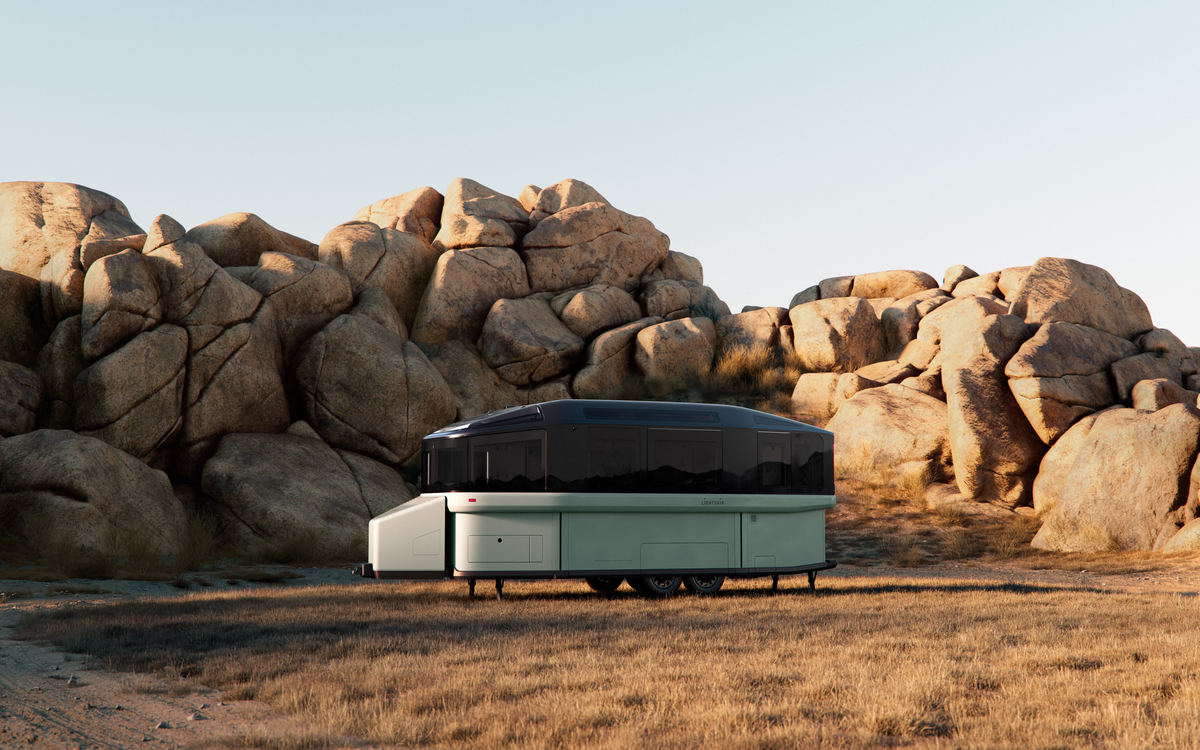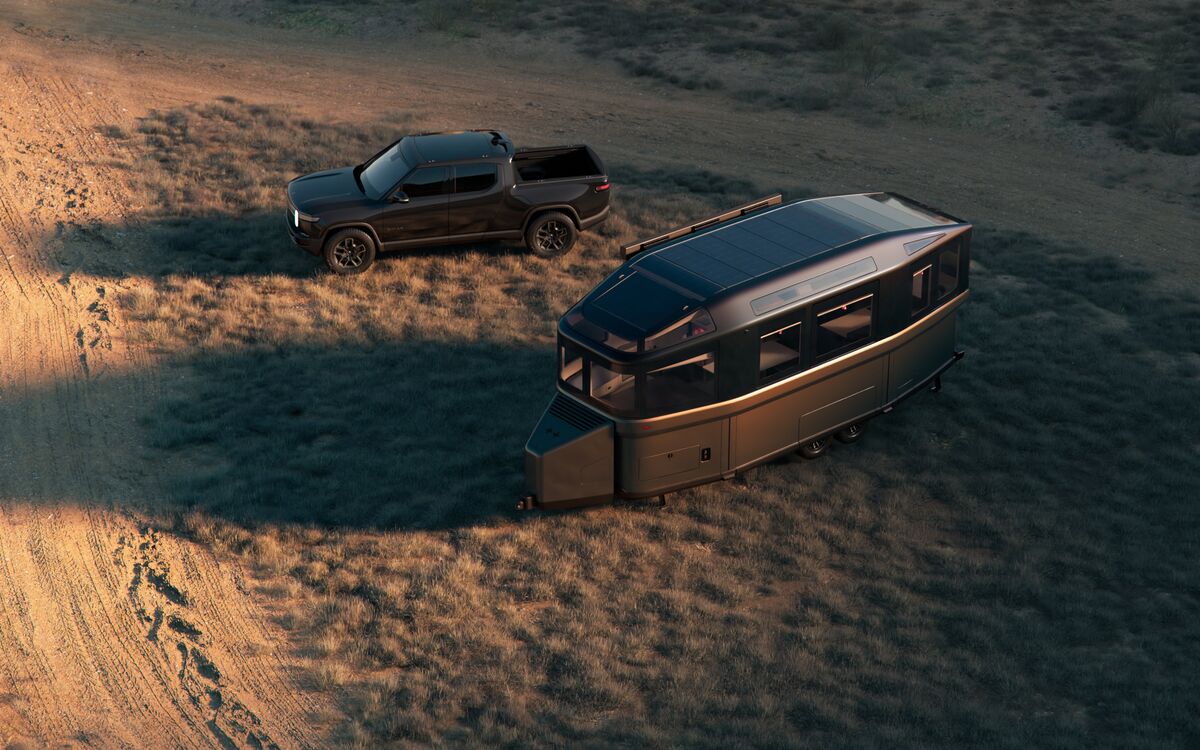Designed From the Ground Up for Efficiency: Lightship L1 Aerodynamics
-
Dec. 15, 2023
-
Amanda Winther
-
11 min read

Are we there yet?
The age-old question children have been asking on road trips since the dawn of time (or at least wheeled vehicles) is now even more panic-inducing when you have to factor in where the next charging station is — a concern EV owners have come to know as “range anxiety.”
When you hit the road towing an RV, this problem only gets worse as the additional drag and weight of the trailer substantially increases your fuel consumption, which means added cost and charge time.
Solving this challenge was a fundamental goal behind the Lightship L1, and we knew the only solution was to design the vehicle from the ground up for extreme efficiency and set a new standard for aerodynamic performance for our vehicle class. Most RVs are designed from the inside out, focusing first on the interior space. This formula doesn’t work when the goal is near zero range or mile-per-gallon efficiency loss for the towing vehicle.
Today, we are taking you behind the curtain to discuss the aerodynamic design elements of the L1, including telescoping walls, a boat-tailed rear, and an optimized tongue box that enabled us to achieve what no other electric RV can claim. But don’t just take our word for it; we’ve also included the test results to prove it.
Our design and engineering teams utilized advanced aerodynamic modeling software, real-world tow testing, and our own experiences traveling across the country towing a vintage travel trailer with a Tesla Model X to make the most efficient electric trailer on the market.
Lightship L1 Dual Mode - Telescoping Design
"From our automotive background, we know that you have to design for efficiency right from the start, and that meant designing the exterior shape first," our co-founder, Ben reflected. Although we started with an exterior shape, we didn’t want to compromise comfort or convenience. That’s how the idea of Dual Mode came to life.
Dual Mode references the telescoping feature of the L1 travel trailer - where the top of the trailer moves relative to the bottom. A completely different approach than most other trailers, this concept allows the hard-sided walls to increase the height and space of the trailer while stationary in Camp Mode and collapse down to reduce the height when traveling in Road Mode.
This innovation allows us to provide a roomy interior with a residential-height ceiling when in Camp Mode. We combine the wide open living space with a solar roof, sleeping capacity for 4-6 depending on the configuration, all-electric appliances, including a dishwasher, and connected features to provide you with a delightful and seamless camping experience.


-
Road Mode - Exterior Height
6'9 ft
-
Camp Mode - Exterior Height
10 ft
-
Camp Mode - Interior Height
7'6 ft
The Most Aerodynamic Towable RV
Aerodynamic simulation and fundamental physics analysis show that our Dual Mode, telescoping approach reduces the CDA value (the Coefficient of Drag and Frontal Area, a metric that shows how aerodynamically efficient a vehicle is) of the trailer by at least 35-40% — more so in varying, windy driving conditions – while preserving a tall ceiling and spacious interior experience. Competitor trailers with fixed-height roofs have significantly higher CDA values since they can only reduce the coefficient of drag given their tall frontal area. They also feel cramped with limited headroom inside.
But Dual Mode wasn’t the only way we reduced the CDA value.
Every part of the L1 travel trailer was optimized for aerodynamics:
Tongue Box: The most important part of any aerodynamic shape is the leading edge, which dictates how the air interacts with the rest of the object downstream. The L1 trailer features a storage box shaped to become part of the aerodynamic concept, stabilizing the flow around the front of the vehicle and reducing the differential between different types of tow vehicles.
Boat-tailed Rear: Shallow angles were used to create a boat-tailed rear. This helps avoid inducing strong vortices, which can increase drag. This shape also protected a central portion of the cabin to ensure that the boat tailing could accommodate the width of a queen-size bed.
Electric Powertrain: The L1 Long Range features its own motor and battery, which allows it to propel itself, reducing the load on the tow vehicle and significantly improving mileage and range.
Thousands of Hours in the Virtual Wind Tunnel
The design decisions mentioned weren’t decided in a vacuum but rather made with the help of an incredibly talented aerodynamicist, using advanced modeling software and an automotive development approach. Traditionally, advanced aerodynamics development is done in a professional wind tunnel that costs tens of millions of dollars.
We recruited Angus Lock, who has spent his entire career helping teams optimize aerodynamics and thermal properties. He served as the Lead Aerodynamicist on the Tesla Roadster, and has advised automotive and aerospace companies including Faraday Future, Volvo, and the Auto Research Center.
Angus and his team at ENGYS have developed Computational Fluid Dynamics (CFD) software to make the process of modeling aerodynamics within a wind tunnel much more cost-effective by bringing it to the virtual space. The same software is used by 60% of the Formula 1 grid.
We started by analyzing the behavior of the airflow around competitor trailers, as well as some of our initial designs. We then conducted a proportion study, where key design parameters were identified and then optimized through a Design of Experiments (DOE) approach to help steer the team to the final design concept.


“Angus and his team did a year of aerodynamic development work before we had any design input. Without this, we wouldn’t have been able to achieve the best-in-class passive efficiency of the L1.” - Ben Parker, co-founder
Fuel Efficiency Testing: Where the Rubber Meets the Road
While we were confident with our optimized design and simulated results, we knew the real world would present challenges that can’t always be accounted for using software.
So, our team put the pedal to the medal (at a brisk 60 mph pace, that is) on a 60-mile stretch of highway to confirm that the L1 Essential Trailer (without the electric powertrain) was truly efficient enough to meet our ultimate range target using the Rivian R1S electric SUV, Rivian R1T electric pickup truck, and a gas-powered Ford F150 truck. To compare, we also towed a bullet-shaped trailer using the same vehicles.
As we had modeled, the L1 Essential Trailer had a significant improvement in efficiency across all tow vehicles when compared to the traditional trailer. When configured as L1 Long Range (electric powertrain included), we confirmed the L1 is efficient enough to deliver a rated 300 miles of range when towed behind a long-range electric truck and excellent fuel economy behind a traditional combustion engine truck.




Lightship L1 Aerodynamics Test Results - Vehicle Towing Efficiency at 60 mph
| Combination | R1T Electric Truck | R1S Electric SUV | F150 Gas Truck |
| Unladen / No Trailer | 2.17 mi/kWh | 1.97 mi/kWh | 23.2 mpg |
| "Bullet shaped" Trailer | 0.93 mi/kWh | 0.96 mi/kWh | 10.2 mpg |
| L1 Essential | 1.26 mi/kWh | 1.33 mi/kWh | 14.4 mpg |
| L1 vs. "Bullet Shaped" | +0.33 mi/kWh (+35%) | +0.37 mi/kWh (+28%) | +4.2 mpg (+29%) |
The tow efficiency test confirmed that whether you own an electric vehicle or gas-powered tow vehicle, you’ll save countless dollars at the pump, plus countless hours waiting to charge for EV owners. People who tow traditional travel trailers with an gas truck today are used to seeing 8-10 mpg on the highway. With the L1 Essential (our offering without the electric drive motor) in tow you’ll get close to 15 mpg towing.
A combination of out-of-the-box thinking, advanced modeling software, and deep interest in building a new product that serves your needs as a camper led us to develop the L1. The outcome is a travel trailer that is 3x as aerodynamic as the status quo while providing a refined, reimagined camping experience.
Goodbye range anxiety, hello open road.
Reserve your L1 today and be one of the first to experience the most aerodynamic travel trailer.
Pick Your AE.1 Journey
Learn more
Why I Chose an AE.1
09.16.2025

Meet the AE.1™ Cosmos Edition
12.11.2024

Where does the name Lightship come from?
10.29.2024





-700x555.png)
